2021 Reports of the Auditor General of Canada to the Parliament of CanadaReport 2—National Shipbuilding Strategy
Independent Auditor’s Report
Table of Contents
- Introduction
- Findings, Recommendations, and Responses
- Conclusion
- Subsequent Events
- About the Audit
- List of Recommendations
- Exhibits:
- 2.1—The large-vessel building projects under the National Shipbuilding Strategy
- 2.2—Delivery schedules for many ships were getting longer
- 2.3—Delays in delivering new ships had many effects
- 2.4—Delivery dates in the contract awarded to build the offshore fisheries science vessels were deferred several times
Introduction
Background
2.1 The Royal Canadian Navy and the Canadian Coast Guard operate several types of vessels to fulfill their respective mandates:
- The navy, a part of the Canadian Armed Forces, supports Canada’s participation in security operations around the world.
- The coast guard, a special operating agency of Fisheries and Oceans Canada, ensures that Canada’s waterways are safe and accessible and supports their sustainable use and development.
2.2 The vessels are used to deliver many essential services, including
- maintaining control of Canadian waters, including in the Arctic
- conducting military operations, including counter-terrorism
- stopping organized crime and illegal immigration
- responding to disasters and major emergencies
- conducting search and rescue missions
- icebreaking to keep waterways open
- conducting research and monitoring to support marine conservation
- maintaining aids for safe navigation, such as buoys
- resupplying northern settlements
2.3 The federal government periodically needs to procure new ships for the navy and the coast guard to replace aging ones and acquire new capabilities. In 2010, the government launched the National Shipbuilding Strategy to guide the renewal of the federal fleet. The strategy was created to address boom-and-bust cycles in the Canadian shipbuilding industry and failed federal procurements to replace ships.
2.4 The strategy’s objectives are to
- renew the federal fleet in a timely and affordable manner
- create and support a sustainable marine sector in Canada
- generate economic benefits for Canada
2.5 The strategy has 3 main elements: large vessel construction; small vessel construction; and repair, refit, and maintenance. This audit focused on large vessels, which are vessels over 1,000 tonnes displacementDefinition 1.
2.6 For large vessel construction, the government’s initial approach under the strategy was to set up a sourcing arrangement with 2 Canadian shipyards to build more than 50 vessels for the navy and the coast guard over about 30 years.
2.7 In 2012, Public Services and Procurement Canada entered into umbrella agreementsDefinition 2 with 2 competitively selected shipyards to build large vessels: Vancouver Shipyards CompanyCo. LimitedLtd. in Vancouver for non-combat vessels and Irving Shipbuilding IncorporatedInc. in Halifax for combat vessels. At that time, the 2 shipyards were assigned to build up to 28 large vessels of different types. Additional ships were expected to be added later.
2.8 In August 2019, Public Services and Procurement Canada announced a competitive process to select a third shipyard to build program icebreakers for the coast guard. In December 2019, the government announced that Chantier Davie Canada IncorporéeInc. in Lévis, Quebec, had pre-qualified to become the third shipyard.
2.9 An interdepartmental deputy minister committee chaired by the Deputy Minister of Public Services and Procurement governs the implementation of the National Shipbuilding Strategy. Supporting committees provide ongoing operational oversight.
2.10 National Defence (on behalf of the Royal Canadian Navy) and the Canadian Coast Guard manage individual shipbuilding projects. Public Services and Procurement Canada is the contracting authority. Innovation, Science and Economic Development Canada negotiates the shipyards’ obligations to generate economic benefits for Canadians, and it monitors and evaluates the shipyards’ performance according to their obligations.
Focus of the audit
2.11 This audit focused on whether the large vessel fleets of the Royal Canadian Navy and the Canadian Coast Guard were being renewed in a timely manner. We examined whether shipbuilding was on schedule and whether the new ships were being delivered in time for the retirement of the old ships. We also looked at how the audited organizations managed the risks of delays, including how they mitigated the potential impact of delays on the navy’s and coast guard’s operations while waiting for new ships. Our audit covered the period from 1 January 2018 to 31 January 2020.
2.12 This audit is important because timely renewal of the navy’s and the coast guard’s fleets is needed to replace aging ships and to introduce new capabilities to deliver essential services.
2.13 More details about the audit objective, scope, approach, and criteria are in About the Audit at the end of this report.
Findings, Recommendations, and Responses
Overall message
2.14 Overall, we found that during the audit period, the National Shipbuilding Strategy was slow to deliver the combat and non-combat ships that Canada needs to meet its domestic and international obligations. The delivery of many ships was significantly delayed, and further delays could result in several vessels being retired before new vessels are operational. National Defence and the Canadian Coast Guard have implemented measures to maintain their operational capabilities until new ships are delivered, but interim capabilities are limited and cannot be extended indefinitely.
2.15 As concerning as these delays are, we recognize that shipbuilding is complex—and that complexity is compounded by the National Shipbuilding Strategy’s objectives of creating a sustainable marine sector and generating economic benefits for Canada. Despite the delays, federal organizations have made adjustments to the strategy’s implementation that improve the prospects of timely future deliveries. Considering that the bulk of new ships are yet to be built, Public Services and Procurement Canada, National Defence, and the Canadian Coast Guard have an opportunity to further improve how they manage risks so that future projects are delivered on schedule and when they are needed.
Current state of fleet renewal
2.16 The National Shipbuilding Strategy calls for building 9 types of large vessels for the Royal Canadian Navy and the Canadian Coast Guard (Exhibit 2.1).
Exhibit 2.1—The large-vessel building projects under the National Shipbuilding Strategy
Royal Canadian Navy
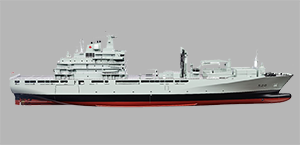
Image credit: Seaspan Shipyards
2 joint support ships
- will replace the core capabilities of auxiliary oiler replenishment ships
- are expected to enable the navy to remain at sea for long periods of time without going to shore for replenishment
- will provide fuel, ammunition, spare parts, food, and water to Canadian and allied vessels
- will provide medical and dental care facilities, as well as helicopter repair capabilities
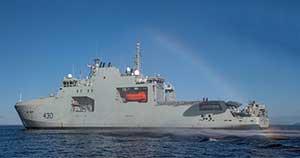
Image credit: National Defence
6 Arctic and offshore patrol ships
- will be able to operate in ice of up to 120 centimetres thick, providing a greater, and longer, navy presence in the north
- will allow the navy to have unescorted access to areas of the Arctic that were previously inaccessible
- will conduct armed surveillance in Canada’s waters and anti-smuggling, anti-piracy, and other international security operations; enforce Canadian sovereignty; and provide humanitarian assistance
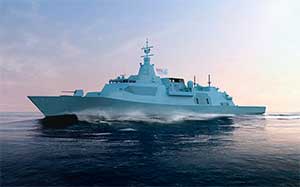
Image credit: British AerospaceBAE Systems
15 Canadian surface combatants
- will provide warfare capability and versatility
- will be able to be deployed rapidly anywhere in the world, either independently or as part of a Canadian and international coalition
Canadian Coast Guard
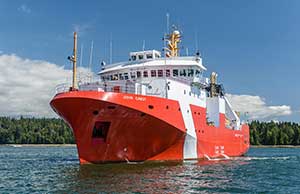
Image credit: Canadian Coast Guard
3 offshore fisheries science vessels
- will include science laboratories and be able to accommodate scientists
- will be used primarily for fisheries and ecosystem research to monitor the health of fish stocks and understand the impact of climate change on the environment
- will support search and rescue missions and environmental response operations
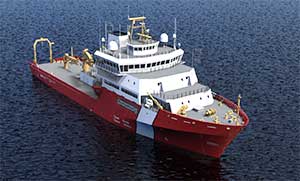
Image credit: Seaspan Shipyards
1 offshore oceanographic science vessel
- will be able to accommodate scientists and be equipped with labs and sampling capabilities
- will be used primarily for oceanographic missions and geological or hydrographic surveys and contribute to the understanding of oceans and of the impact of climate change
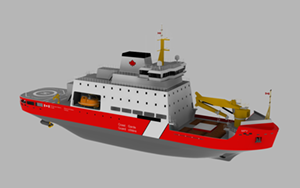
Image credit: Canadian Coast Guard
16 multi-purpose vessels
- will replace a number of existing coast guard ships
- will provide icebreaking, recover and maintain navigation aids, conduct search and rescue missions, and assist disabled vessels
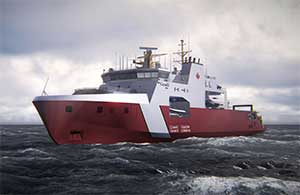
Image credit: Halifax Shipyard
2 Arctic and offshore patrol ships
- will be built on the basis of the navy’s model but be modified to meet the requirements for civilian vessels and the coast guard
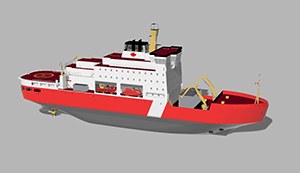
Image credit: Canadian Coast Guard
6 program icebreakers
- will support year-round marine trade in Eastern Canada, the SaintSt. Lawrence waterways, and the Great Lakes
- will provide icebreaking services to allow commercial ships access to Canadian ports during the winter
- will supply goods to Canada’s Arctic communities and their industries during the summer
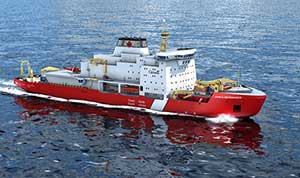
Image credit: Canadian Coast Guard
1 polar icebreaker
- will be Canada’s first polar-class icebreaker
- will be able to operate farther north in the Arctic, in more difficult conditions, and for longer than is now possible
2.17 Under the umbrella agreements, the 2 shipyards agreed to attain target state—that is, to have facilities, human resources, and processes and practices that meet international ship-construction benchmarks. This would enable the shipyards to efficiently build their assigned vessels at the required rate. The government plans to put in place similar requirements when it establishes the third shipyard under the strategy.
2.18 These agreements were not contracts to build ships. Instead, they set out guidelines for negotiating contracts. Since 2012, the federal government has entered into several contracts with the 2 shipyards. Each major phase of every shipbuilding project was subject to a separate contract.
2.19 Before the audit period, the ship delivery dates set during the early years of the strategy’s implementation had been missed by several years. The government acknowledged that it, along with the shipyards, had been overly optimistic, considering that whole new classes of ships were being built in new shipyards by new workforces.
Federal fleet was not being renewed in a timely manner
2.20 We found that the federal fleet renewal experienced many delays in design and construction. Only 2 of 4 ships scheduled at the start of the audit period to be delivered by January 2020 were delivered, and both were late. Expected delivery dates for other vessels were also pushed back during the audit period, by years in some cases. The practices established by the National Shipbuilding Strategy were not fully effective in managing risks of delays.
2.21 The analysis supporting this finding discusses the following topics:
- Persistent shipbuilding delays
- Schedule management weaknesses
- Inadequate risk management tools
- Delays in confirming achievement of target state
2.22 This finding matters because the late delivery of ships for the Royal Canadian Navy and the Canadian Coast Guard could put at risk Canada’s ability to perform critical operations. These operations support the navy’s peace, defence, and security missions in Canada and around the world and the coast guard’s search and rescue missions, icebreaking, and other operations to ensure safety in Canadian waters.
2.23 Our recommendations in this area of examination appear at paragraphs 2.36, 2.46, and 2.49.
Persistent shipbuilding delays
2.24 We found that the delivery of ships was often delayed and that delivery schedules were getting longer.
2.25 We compared the working schedules that were used to manage the vessel projects at the beginning of the audit period (January 2018) with those used at the end of the audit period (January 2020). We found that the projected and actual deliveries of most of these vessels were delayed by several months or years (Exhibit 2.2).
Exhibit 2.2—Delivery schedules for many ships were getting longer
| Vessel type and number to be built | Client | Scheduled delivery date as of January 2018 | Actual or revised forecast delivery date as of January 2020 | Status of vessel at end of audit periodNote * | |
|---|---|---|---|---|---|

Ships assigned to Vancouver Shipyards CompanyCo. LimitedLtd. (Vancouver) |
3 Offshore fisheries science vessels |
Canadian Coast Guard | First: August 2018 | June 2019 (10 months later) |
Delivered |
| Second: March 2019 | November 2019 (8 months later) |
Delivered | |||
| Third: July 2019 | August 2020 (13 months later) |
Under construction | |||
| 2 Joint support ships |
Royal Canadian Navy | First: May 2023 | July 2023 (2 months later) |
Under detailed design; hull components under construction | |
| Second: October 2024 | September 2025 (11 months later) |
||||
| 1 Offshore oceanographic science vessel |
Canadian Coast Guard | October 2021 | April 2024 (30 months later) |
Under detailed design; build contract yet to be awarded | |
| 16 Multi-purpose vessels |
Canadian Coast Guard | No schedule at that time | First ship to be delivered in 2027, and 16th ship to be delivered by 2042 | Assigned to the shipyard in 2019 | |

Ships assigned to Irving Shipbuilding IncorporatedInc. (Halifax) |
6 Arctic and offshore patrol ships |
Royal Canadian Navy | First: June 2019 | March 2020 (9 months later) |
Under construction |
| Second: April 2020 | December 2020 (8 months later) |
Under construction | |||
| Third to sixth: November 2020 to August 2022 |
November 2021 to March 2024 (on average 16 months later) |
Third and fourth ships under construction | |||
| 2 Arctic and offshore patrol ships |
Canadian Coast Guard | No schedule at that time | 2024 and 2025 | Assigned to the shipyard in 2019 | |
| 15 Canadian surface combatants |
Royal Canadian Navy | First: mid-2020s | 2030 | Under design; build contract yet to be awarded | |
| No schedule for the remaining vessels | No schedule for the remaining vessels; 15th estimated to be delivered in 2047 | ||||

Vessels to be assigned to third shipyard in process of being selected |
6 Program icebreakers |
Canadian Coast Guard | No schedule at that time | Preliminary timeline: first ship to be delivered in 2027–29, and sixth ship to be delivered in 2037–39 | Yet to be designed |

Vessel with an undetermined location of build |
1 Polar icebreaker |
Canadian Coast Guard | No schedule at that time | Delivery targeted for 2029–30 | Design completed in 2014 was being refreshed; government was in the process of determining a procurement strategy |
2.26 The biggest challenge was the design and production of the first vessels of a given class. For example, the first vessel class built and delivered was the offshore fisheries science vessel. Construction was well advanced before welding problems were discovered, which resulted in delays because of the need to investigate and repair several welds on the ships. These delays then cascaded to subsequent vessels.
2.27 In 2019, to replace the coast guard’s aging vessels, 18 additional large vessels were assigned to the 2 shipyards:
- 2 Arctic and offshore patrol ships, to be built by Irving Shipbuilding IncorporatedInc.
- 16 multi-purpose vessels, to be built by Vancouver Shipyards CompanyCo. LimitedLtd.
2.28 In addition, 6 program icebreakers were also to be built at the third Canadian shipyard.
2.29 We found that delays had several consequences for government activities. Exhibit 2.3 shows some of the effects.
Exhibit 2.3—Delays in delivering new ships had many effects
| Effect | Examples |
|---|---|
|
There were delays in introducing new capabilities and replacing capabilities lost when older vessels were retired. |
Delays in building the Arctic and offshore patrol ships and the polar icebreaker postponed increasing the government’s capabilities to operate in Arctic waters. Delays in delivering the Canadian surface combatants meant that the Royal Canadian Navy would have to wait longer to replace long-range air defence capabilities that were lost after it retired its destroyers. Delays in the offshore oceanographic science vessel and the offshore fisheries science vessels hampered marine research and monitoring. The new vessels would also provide much improved platforms for science research. |
|
Older vessels had their lives extended. Other steps were taken to support operations while waiting for new vessels. |
The Canadian Coast Guard had to extend the life of the Canadian Coast Guard Ship Hudson, which the offshore oceanographic science vessel was to replace. This work included a $10-million life extension contract awarded in 2019. The coast guard had to charter commercial vessels to help carry out marine research and monitoring. |
|
Costs increased. |
In 2019, National Defence estimated that design costs for the Canadian surface combatant would increase by $111 million because of delays. Because the contract terms limited the direct labour hours that could be charged to build the offshore fisheries science vessels, the government amended the contract to increase the portion of indirect costs that could be billed by at least $39.8 million up to a maximum of $101.5 million. |
|
Delays in a vessel created delays in subsequent vessels. |
Delays in building the first offshore fisheries science vessel delayed the construction of the second and third vessels of this type. |
Schedule management weaknesses
2.30 We found that the government identified unreliable schedules as a risk for several projects but its efforts to address this risk were not always effective. Schedule management is key to efficient and effective shipbuilding projects and is part of the standards required for shipyards to reach target state.
2.31 The National Shipbuilding Strategy used a series of contracts for all phases of shipbuilding projects, from design through pre-building phases, such as construction engineering, to the building phase. All contracts required the shipyards to provide detailed production schedules to government officials on various aspects and stages of projects and to update these schedules regularly. The contracts that were supporting the ships’ building phases also included delivery dates.
2.32 We found that the 2 contracts in place at the time of the audit to build and deliver new ships were often amended to postpone the delivery dates as those dates approached. The contract awarded in 2014 to build the Royal Canadian Navy’s Arctic and offshore patrol ships was amended in January 2017 and in December 2018 to postpone the delivery dates of each ship by 1 to 2 years. The first ship, Her Majesty’s Canadian Ship Harry DeWolf, initially expected to be delivered in May 2018, was postponed to December 2018 and then to June 2019. It was finally delivered in July 2020.
2.33 The contract to build the offshore fisheries science vessels was also amended twice to introduce target delivery dates and to defer these target dates as well as the required delivery dates (Exhibit 2.4).
Exhibit 2.4—Delivery dates in the contract awarded to build the offshore fisheries science vessels were deferred several times
Planned delivery dates
| Contract key dates | First ship | Second ship | Third ship |
|---|---|---|---|
| Original contract 2015 | Delivery required by: March 2017 |
Delivery required by: September 2017 |
Delivery required by: December 2017 |
| Amended August 2017 | Delivery targeted for:Note * 1 January to 30 April 2018 |
Delivery targeted for:Note * 1 May to 30 November 2018 |
Delivery targeted for:Note * 1 December 2018 to 30 April 2019 |
| Amended November 2019 | Delivery targeted for:Note ** During June 2019 |
Delivery targeted for:Note ** By 31 December 2019 |
Delivery targeted for:Note ** During August 2020 |
Actual delivery dates
| Type of vessel | First ship | Second ship | Third ship |
|---|---|---|---|
| Canadian Coast Guard Ship | Sir John Franklin June 2019 |
CaptainCapt. Jacques Cartier November 2019 |
John Cabot October 2020 |
Source: Based on documents provided by Public Services and Procurement Canada
2.34 We also found that schedules were often not an effective tool to manage projects’ timeliness. For several projects, government officials were not satisfied with the schedules they received. They considered the schedules to be incomplete, partly because the schedules were too general and underestimated the time needed to accomplish the different tasks. They also considered them to not be provided in a timely manner. For example, in the case of the Canadian surface combatant, it took more than 6 months after the start of the design phase for the government to obtain a design schedule that was sufficiently detailed to accurately track progress.
2.35 This lack of information impeded the government’s ability to fully understand expected progress and to monitor performance accordingly.
2.36 Recommendation. The Canadian Coast Guard, National Defence, and Public Services and Procurement Canada should implement mechanisms to
- obtain complete, current, and reliable schedules to support shipbuilding projects
- ensure that progress toward forecast targets and delivery timelines is monitored to enable timely decision making
The organizations’ response. Agreed. Fisheries and Oceans Canada (the Canadian Coast Guard), National Defence, and Public Services and Procurement Canada agree that having complete, current, and reliable schedules is essential for decision making and management of the shipbuilding projects. Departments will continue to work together and with shipyards to improve delivery and accuracy of schedules and ensure more disciplined reporting of progress toward targets. Current tools, such as the shipyard-produced integrated project schedules, and approaches, including earned value management, will be further matured to ensure that cost and schedule are properly managed and to support oversight by governance committees at all levels.
Inadequate risk management tools
2.37 We found that the tools for assessing, mitigating, and monitoring risks were weak.
2.38 The National Shipbuilding Strategy had a high-level risk management framework and practices in place to identify and assess risks, develop mitigation strategies, and monitor and report on risk management plans. For example, it had a risk management committee composed of senior officials from the participating departments, which was supported by a risk management team.
2.39 We found that the tools used to manage risks were limited. The main tools were a risk register database (a Microsoft Excel spreadsheet) to identify and track all risks and an individual risk sheet (a 2-page Microsoft Word document) for each risk. In early 2018, the risk management team concluded that these tools could not be used for detailed risk analysis because they
- took too much time and effort
- resulted in duplication
- produced too many human errors
2.40 To address these problems, the team acquired risk management software in 2018, which failed to resolve the problems. As a result, the team stopped using the software and went back to using the manual process to manage risks.
2.41 All risks were part of the defined risk management process, and the team analyzed some risks in detail, using third-party experts. However, the team did not analyze some risks that had an impact on shipbuilding timeliness.
2.42 For example, one risk was not having enough staff within departments to implement the strategy in a timely manner. The team did not document whether this risk was affecting the pace of implementing the strategy. Other risks were not having enough workers at each shipyard, which could affect timely delivery of vessels. Again, the team did not document how these risks were affecting timely shipbuilding. We noted instances where such staff shortages caused shipbuilding delays.
2.43 Subsequently, in December 2019, Public Services and Procurement Canada prepared a draft work plan to develop and implement a human resource strategy. One of the early steps in the plan is to assess whether the government and industry have the capacity to carry out the strategy.
2.44 We also found weaknesses in risk mitigation planning. The risk registers and risk information sheets, the key tools used to document risk mitigation plans, contained little planning information. For example, the sheets identified high-level strategies in some instances but did not include specific actions on how to implement them or set deadlines to complete them.
2.45 Also, we found a weakness in the monitoring of these plans. The risk documents we reviewed contained so little information that we could not determine to what extent the mitigation actions identified had been implemented.
2.46 Recommendation. Public Services and Procurement Canada should improve risk management tools at the National Shipbuilding Strategy’s management level to enable
- thorough risk analysis
- specific, time-bound, and measurable risk mitigation action plans
- better monitoring of the implementation of risk mitigation measures
The department’s response. Agreed. Public Services and Procurement Canada will improve risk management tools used to support the management of risks. These risk management tools will ensure that all relevant information is available to decision makers and ensure clarity and transparency.
Delays in confirming achievement of target state
2.47 We found that Public Services and Procurement Canada had not yet confirmed that the first 2 shipyards had achieved target state—that is, met international ship-construction standards to enable efficient ship production. The 2012 umbrella agreements with the first 2 shipyards had not set a mandatory date to achieve target state. However, these agreements set the expectation that the non-combat shipyard would achieve target state within about 3 years and the combat shipyard within about 6 years. In 2019, the umbrella agreement with the combat shipyard (Irving Shipbuilding IncorporatedInc.) was amended to allow it 4 more years to achieve target state.
2.48 In 2018, the level of target state achieved by the non-combat shipyard (Vancouver Shipyards CompanyCo. LimitedLtd.) was assessed by a third-party expert. At the time of our audit, government officials were reviewing the shipyard’s corrective action plan. The level of target state achieved by the combat shipyard (Irving Shipbuilding IncorporatedInc.) is expected to be assessed before February 2022. We also noted that the National Shipbuilding Strategy had identified risks to attaining target state.
2.49 Recommendation. Public Services and Procurement Canada should consider the experience of the first 2 shipyards in determining a schedule to achieve target state for the third shipyard.
The department’s response. Agreed. The target state requirement is an important facet of the National Shipbuilding Strategy. Public Services and Procurement Canada is applying to the third shipyard the lessons learned from the first 2 strategy shipyards in terms of the timing of assessments within the target state process.
Completing federal fleet renewal
Key decisions improved the prospects for timely fleet renewal, but there is little room for further delay
2.50 We found that the government made several key decisions during the audit period to address significant risks to achieving the National Shipbuilding Strategy’s objectives, including risks to the federal fleet’s timely renewal. These decisions were mainly driven by delays in designing and building the initial ships, but overall, they increased the likelihood that the federal large vessel fleet would be renewed in a timely manner.
2.51 Nonetheless, because of the expected end of life of many aging vessels, there was little room for further delay, even with life extensions, to deliver replacement vessels. It was also uncertain whether the polar icebreaker would be ready when the vessel it is to partially replace goes out of service because it is not yet known when or where the icebreaker would be built.
2.52 The analysis supporting this finding discusses the following topics:
- Key decisions made on fleet renewal
- Aging vessels reaching the end of their useful lives
- Incomplete procurement plans for completing the renewal of the Canadian Coast Guard’s large vessel fleet
2.53 This finding matters because the Royal Canadian Navy’s and the Canadian Coast Guard’s fleets could have capability gaps if new vessels are not delivered in time to replace aging vessels as they are retired. Once a vessel is delivered, it takes time before it is ready to be integrated into operations.
2.54 Most of the vessels still to be built under the National Shipbuilding Strategy will replace aging vessels and a few that have already been retired. For example, the Canadian Coast Guard’s future fleet of multi-purpose vessels and Arctic and offshore patrol ships will replace its aging medium endurance multi-tasked vessels, high endurance multi-tasked vessels, and offshore patrol vessels.
2.55 Some vessels had already been retired before being replaced under the strategy. These include
- the Canadian Coast Guard Ship W.E. Ricker, retired in 2016 before it could be replaced by the first offshore fisheries science vessel, which was delivered in 2019
- the Royal Canadian Navy’s 3 destroyers, the last of which was retired in 2017, which are to be replaced by Canadian surface combatants
- the navy’s auxiliary oiler replenishment ships, retired in 2014, which are to be replaced by the joint support ships
2.56 We made no recommendations in this area of examination.
Key decisions made on fleet renewal
2.57 During the audit period, the National Shipbuilding Strategy’s management team considered the advice of third-party experts to address several significant risks to achieving the strategy’s objectives. We found that by the end of the audit period, the team had developed more realistic assumptions about scheduling timelines as a result of the shipbuilding experience gained over the years. However, the team’s decisions also lengthened the delivery schedules for several vessels.
2.58 For example, the delays experienced in the surface combatant project were expected to reduce activities at Irving Shipbuilding IncorporatedInc. after the Arctic and offshore patrol ships were built. Government officials took steps to minimize the impact of this situation on the workforce. They estimated that doing nothing would further delay the delivery of the first surface combatant by 3 years, because of the time the shipyard needed to rebuild its workforce, and would cost an estimated $890 million. These steps included the following:
- Build the Arctic and offshore patrol ships for the navy over a longer period of time than planned. This delayed the planned delivery of the second to sixth ships by about 13 months each on average, which increased their cost.
- Assign 2 additional Arctic and offshore patrol ships to Irving Shipbuilding IncorporatedInc. to replace aging Canadian Coast Guard vessels instead of building 2 multi-purpose vessels. According to government analysis, these were expected to provide the coast guard with new vessels sooner but cost more to build and operate.
2.59 Another significant problem was the sustainability of shipbuilding operations at Vancouver Shipyards CompanyCo. LimitedLtd. As a result of a firm-price contract combined with underestimating the time and effort to build the offshore fisheries science vessels, the shipbuilder had sustained significant financial losses. This not only threatened the strategy’s overall objective of creating a sustainable marine industry, but also put the renewal of the federal fleet in peril. To help address this, the government took several steps.
2.60 For example, the government, through an agreement with the shipyard, changed the order in which the joint support ships and the offshore oceanographic science vessel would be built. While this change was expected to improve the shipyard’s efficiency, it affected the offshore oceanographic science vessel’s and the second joint support ship’s schedules.
2.61 In addition, in 2019, Public Services and Procurement Canada initiated a process to select a third shipyard under the strategy to build 6 program icebreakers. The government reported that it had initially assumed that the first 2 shipyards would be able to build the ships within the required time frames but had since determined that they could not.
Aging vessels reaching the end of their useful lives
2.62 Partly because of failed procurements, by the time the National Shipbuilding Strategy was launched, several federal ships were already at or beyond their expected service lives. According to departmental documents, all of the vessels to be replaced under the strategy will need to be retired within the next 30 years, even with life extensions. Many are expected to be retired much earlier.
2.63 We compared the expected end-of-service dates of current vessels, including expected life extensions, with delivery schedules for the new vessels. We found that further delays could result in vessels being retired before they are replaced. For example, the Canadian Coast Guard’s tentative schedule for the new program icebreakers to be built at a third shipyard shows that most would be delivered by the time the aging icebreakers reach their estimated extended service lives. According to this schedule, the first program icebreaker is to be delivered about 9 years after the coast guard enters into an umbrella agreement with the third shipyard, which at the end of our audit period was targeted for late 2020. This is similar to how long it took the first 2 shipyards to start delivering vessels. However, any delays in building these icebreakers or the need to retire vessels earlier than expected could result in capability gaps for the icebreaking program.
2.64 The preliminary delivery schedules for the multi-purpose vessels to be built for the coast guard also showed the vessels being delivered when the ships they are replacing reach the end of their extended service lives.
2.65 At the time of our audit, the first Canadian surface combatant for the Royal Canadian Navy was not expected to be delivered until at least 2030. Very preliminary schedules showed the last ship being delivered in 2047. According to departmental documents, the navy’s Halifax-class frigates, which will be replaced by the surface combatants, are expected to be retired sometime between 2034 and 2048. Therefore, there is little room for further delay.
2.66 In all these cases, delivery schedules available at the time of the audit were preliminary and are thus subject to change.
Incomplete procurement plans for completing the renewal of the Canadian Coast Guard’s large vessel fleet
2.67 We found that the Canadian Coast Guard did not have a revised plan for where it will build the polar icebreaker needed to provide new capabilities and to help replace capabilities lost when an aging heavy icebreaker is retired.
2.68 The coast guard’s most immediate need was to build a polar icebreaker by 2029–30, a project that had been repeatedly postponed over the years. This icebreaker is intended to carry out summertime operations in the Arctic and to provide enhanced capabilities, such as an ability to operate longer each year there. At the time of our audit, the coast guard was extending the life of the current icebreaker, the Canadian Coast Guard Ship Louis S. SaintSt-Laurent, to 2029–30. The government was deciding on a new procurement strategy to select a shipbuilder for the polar icebreaker so it could be delivered by that date.
2.69 The coast guard also identified the need for 2 additional vessels. To advance these 2 projects, a procurement strategy would be needed and Fisheries and Oceans Canada would need to obtain government approval and funding.
The government took some steps to manage aging vessels while waiting for new ones
2.70 We found that the government had taken steps to extend the lives of its aging vessels and acquire interim capabilities to continue delivering essential services, but progress was delayed.
2.71 The analysis supporting this finding discusses the following topic:
2.72 This finding matters because the Royal Canadian Navy and the Canadian Coast Guard need fleets that are reliable and can maintain their capabilities so they can fulfill their mandates.
2.73 We made no recommendations in this area of examination.
Further steps for delivering essential services
2.74 We found that the government had taken several steps to continue to provide essential services until new vessels are delivered under the National Shipbuilding Strategy. However, as with shipbuilding, the implementation of these steps was hindered by delays. We also found that further steps were needed.
2.75 While waiting for replacement vessels, both National Defence and the Canadian Coast Guard began to extend the lives of their aging vessels, such as the Royal Canadian Navy’s Halifax-class frigates, but more work is needed. Because most of the Canadian Coast Guard’s aging vessels will reach their end-of-service lives before new vessels are delivered, the coast guard has identified the need to successfully extend the service lives of over 20 of its large vessels. For example, work was underway to extend the life of the Canadian Coast Guard Ship Hudson, to be replaced by the offshore oceanographic science vessel, scheduled to be delivered in 2024. However, the life extension work has taken longer than planned.
2.76 Both National Defence and Fisheries and Oceans Canada have taken further steps to help sustain operations, but these have not been fully effective. For example, Fisheries and Oceans Canada was able to successfully carry out some ocean research by chartering a vessel. However, it cancelled other research because it was unable to secure a suitable vessel. In another example, the government bought 3 used icebreakers for the coast guard to supplement its aging icebreakers while they are out of service. Before the used icebreakers could be fully put back into service, they had to be modified to meet operational needs and regulatory requirements, but this work experienced delays.
2.77 Decisions will need to be made to sustain naval operations while waiting for the new joint support ships. For example, National Defence leased a supply ship, the Motor Vessel Asterix. According to post-mission reports, this vessel functioned as intended. However, according to project schedules, the first new support ship will not be ready for operations until 2024 and the lease will end in 2023. National Defence told us that it had not yet decided how it would proceed. Its decision will depend on several factors, including how the delivery schedule for the joint support ship will evolve and whether military crew members will be available when needed.
Conclusion
2.78 We concluded that National Defence; Fisheries and Oceans Canada; Public Services and Procurement Canada; and Innovation, Science and Economic Development Canada did not manage the National Shipbuilding Strategy in a manner that supported timely renewal of the federal large vessel fleet during the audit period, but they did address issues that threatened the future renewal of the federal fleet. Ships continued to be delayed, and schedule and risk management practices needed to be improved. However, the departments made key decisions during the audit period to place the strategy on a more viable path. They also took steps to help sustain operations until new ships could be delivered, but there was little room for further delay. Delaying could result in a loss of capability to deliver essential government programs.
Subsequent Events
2.79 The audit period covered 1 January 2018 to 30 January 2020. In subsequent months, the coronavirus disease (COVID-19) pandemic began affecting shipbuilding projects underway at the shipyards. Work disruptions were more pronounced for construction activities than for design and engineering work, which could be done by employees at home. Irving Shipbuilding IncorporatedInc. temporarily shut down most of its shipbuilding, and Vancouver Shipyards CompanyCo. LimitedLtd. operated at reduced capacity. The pandemic caused some delays for the vessels scheduled to be delivered in 2020. Both shipyards signalled their intentions to exercise “excusable delay” provisions in their contracts with Canada, which may, for example, enable the shipyards to seek the government’s agreement to postpone contractual delivery dates. However, as the pandemic was still ongoing, the full impact of the delays was not yet known.
2.80 Also, 2 additional vessels were delivered—the first Arctic and offshore patrol ship in July 2020 and the third and final offshore fisheries science vessel in October 2020. Both ships were delivered later than was scheduled in January 2020.
About the Audit
This independent assurance report was prepared by the Office of the Auditor General of Canada on the National Shipbuilding Strategy. Our responsibility was to provide objective information, advice, and assurance to assist Parliament in its scrutiny of the government’s management of resources and programs, and to conclude on whether the strategy’s management complied in all significant respects with the applicable criteria.
All work in this audit was performed to a reasonable level of assurance in accordance with the Canadian Standard on Assurance Engagements (CSAE) 3001—Direct Engagements, set out by the Chartered Professional Accountants of Canada (CPA Canada) in the CPA Canada Handbook—Assurance.
The Office of the Auditor General of Canada applies the Canadian Standard on Quality Control 1 and, accordingly, maintains a comprehensive system of quality control, including documented policies and procedures regarding compliance with ethical requirements, professional standards, and applicable legal and regulatory requirements.
In conducting the audit work, we complied with the independence and other ethical requirements of the relevant rules of professional conduct applicable to the practice of public accounting in Canada, which are founded on fundamental principles of integrity, objectivity, professional competence and due care, confidentiality, and professional behaviour.
In accordance with our regular audit process, we obtained the following from entity management:
- confirmation of management’s responsibility for the subject under audit
- acknowledgement of the suitability of the criteria used in the audit
- confirmation that all known information that has been requested, or that could affect the findings or audit conclusion, has been provided
- confirmation that the audit report is factually accurate
Audit objective
The objective of this audit was to determine whether National Defence; Fisheries and Oceans Canada; Public Services and Procurement Canada; and Innovation, Science and Economic Development Canada managed the National Shipbuilding Strategy in a manner that supported timely renewal of the federal large vessel fleet.
Scope and approach
Our audit looked at whether the implementation of the National Shipbuilding Strategy was renewing the large vessel fleets of the Royal Canadian Navy and the Canadian Coast Guard in a timely manner. In particular, we examined whether progress made during the audit period was in keeping with the schedules in place at the beginning of the audit period. We also looked at whether the new ships were being delivered in time to replace aging ships before they were to be retired. Our primary source of audit evidence was documentation, such as government decision documents, schedules, risk management documents, minutes and supporting documents of key National Shipbuilding Strategy committees, and departmental studies and analysis.
We also examined whether the federal government was mitigating the potential impact of shipbuilding delays on the navy’s and coast guard’s operations.
This was an audit of the federal government. We did not audit the shipbuilders and other contractors, and our observations and conclusions pertain only to the federal government’s management. We did, however, visit the 2 selected shipyards, where we met with company officials. We also reviewed documents provided by the shipyards to the federal government, such as shipbuilding schedules, risk registers, and progress reports.
We did not audit the management of individual shipbuilding projects. For example, we did not examine whether the vessels built provided the expected capabilities. We also did not examine the timing of other activities outside of shipbuilding needed to integrate the new vessels into operations, such as crewing, training, federal infrastructure, and repair and maintenance. We also did not examine federal large vessels not included under the National Shipbuilding Strategy at the time of our audit, notably Transport Canada’s ferries.
Criteria
We used the following criteria to determine whether National Defence; Fisheries and Oceans Canada; Public Services and Procurement Canada; and Innovation, Science and Economic Development Canada managed the National Shipbuilding Strategy in a manner that supported timely renewal of the federal large vessel fleet:
| Criteria | Sources |
|---|---|
|
The federal fleet is being renewed in a timely manner. |
National Shipbuilding Strategy, Public Services and Procurement Canada National Shipbuilding Procurement Strategy Governance Terms of Reference, Public Works and Government Services Canada, 2010 Governance of the Defence Procurement Strategy and related procurements—Terms of Reference, Public Works and Government Services Canada, 2015 Policy Framework for the Management of Assets and Acquired Services (rescinded 11 October 2019), Treasury Board of Canada Secretariat Policy on the Management of Projects, Treasury Board Directive on the Management of Projects and Programmes, Treasury Board, 2019 Strong, Secure, Engaged—Canada’s Defence Policy, National Defence, 2017 |
|
Risks to the timely delivery of ships are identified and assessed. Risk mitigation measures related to the timely delivery of ships are defined and implemented. The implementation of risk mitigation measures related to the timely delivery of ships is monitored and reported. |
National Shipbuilding Procurement Strategy Governance Terms of Reference, Public Works and Government Services Canada, 2010 Governance of the Defence Procurement Strategy and related procurements—Terms of Reference, Public Works and Government Services, 2015 Framework for the Management of Risks, Treasury Board of Canada Secretariat, 2010 Acquisitions Program Risk Assessment Framework, Public Services and Procurement Canada, 2015 Directive on the Management of Projects and Programmes, Treasury Board, 2019 Guide to Risk Statements, Treasury Board of Canada Secretariat, 2013 Strong, Secure, Engaged: Canada’s Defence Policy, National Defence, 2017 |
Period covered by the audit
The audit covered the period from 1 January 2018 to 31 January 2020. This is the period to which the audit conclusion applies. However, to gain a more complete understanding of the subject matter of the audit, we also examined certain matters that preceded the start date of this period.
Date of the report
We obtained sufficient and appropriate audit evidence on which to base our conclusion on 18 December 2020, in Ottawa, Canada.
Audit team
Principal: Nicholas Swales
Director: Daniel Thompson
Director: Chantal Thibaudeau
Cyril Catto
Sophie Chen
Jan Jones
Manav Kapoor
Karen Persad
Stephanie Taylor
List of Recommendations
The following table lists the recommendations and responses found in this report. The paragraph number preceding the recommendation indicates the location of the recommendation in the report, and the numbers in parentheses indicate the location of the related discussion.
Current state of fleet renewal
| Recommendation | Response |
|---|---|
|
2.36 The Canadian Coast Guard, National Defence, and Public Services and Procurement Canada should implement mechanisms to
|
The organizations’ response. Agreed. Fisheries and Oceans Canada (the Canadian Coast Guard), National Defence, and Public Services and Procurement Canada agree that having complete, current, and reliable schedules is essential for decision making and management of the shipbuilding projects. Departments will continue to work together and with shipyards to improve delivery and accuracy of schedules and ensure more disciplined reporting of progress toward targets. Current tools, such as the shipyard-produced integrated project schedules, and approaches, including earned value management, will be further matured to ensure that cost and schedule are properly managed and to support oversight by governance committees at all levels. |
|
2.46 Public Services and Procurement Canada should improve risk management tools at the National Shipbuilding Strategy’s management level to enable
|
The department’s response. Agreed. Public Services and Procurement Canada will improve risk management tools used to support the management of risks. These risk management tools will ensure that all relevant information is available to decision makers and ensure clarity and transparency. |
|
2.49 Public Services and Procurement Canada should consider the experience of the first 2 shipyards in determining a schedule to achieve target state for the third shipyard. (2.47 to 2.48) |
The department’s response. Agreed. The target state requirement is an important facet of the National Shipbuilding Strategy. Public Services and Procurement Canada is applying to the third shipyard the lessons learned from the first 2 strategy shipyards in terms of the timing of assessments within the target state process. |

